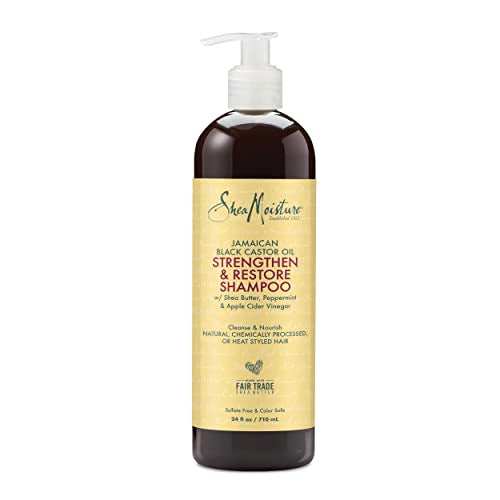

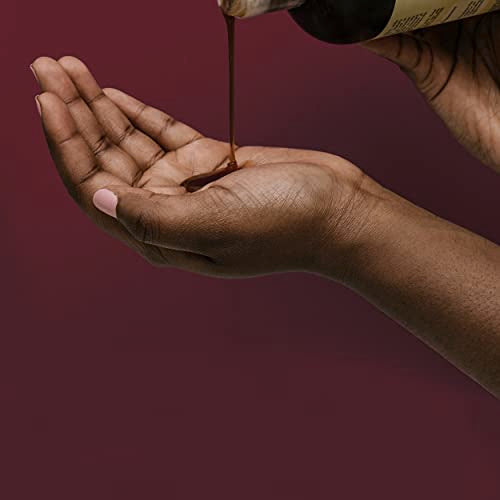
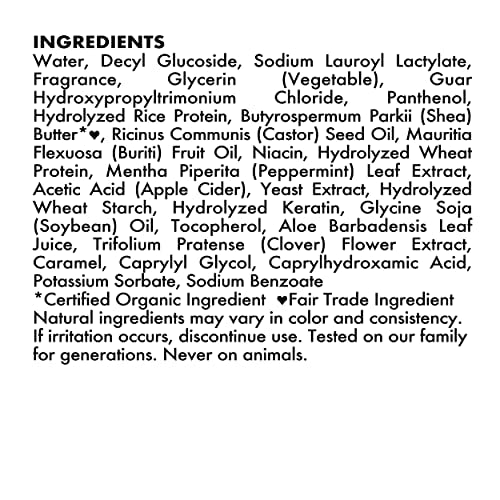
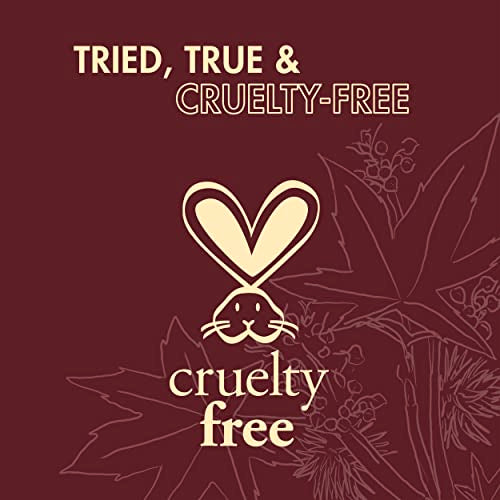
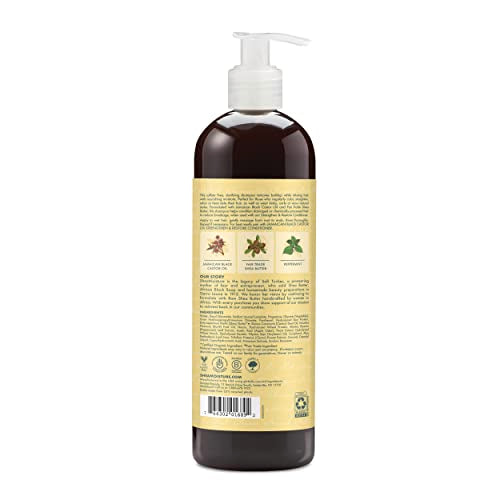
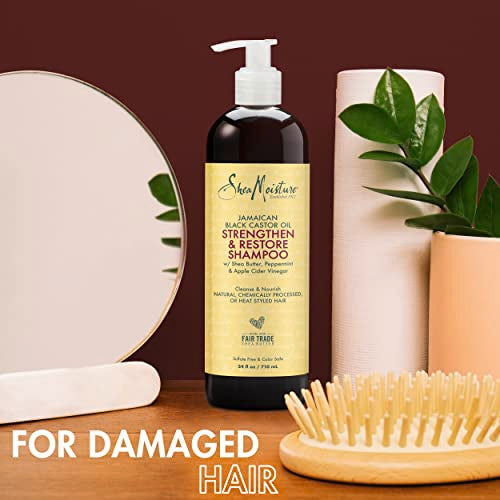
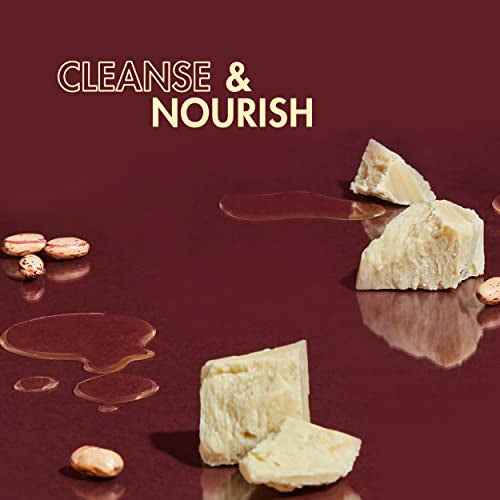
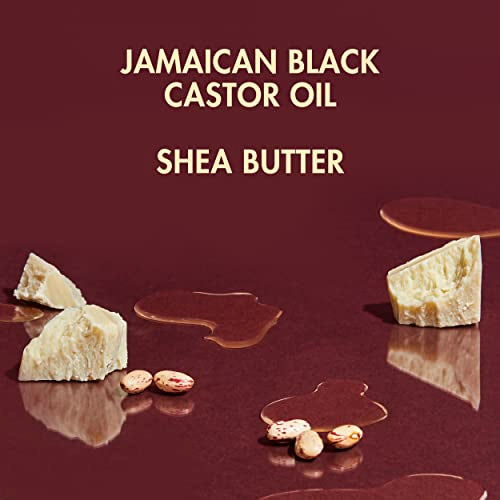
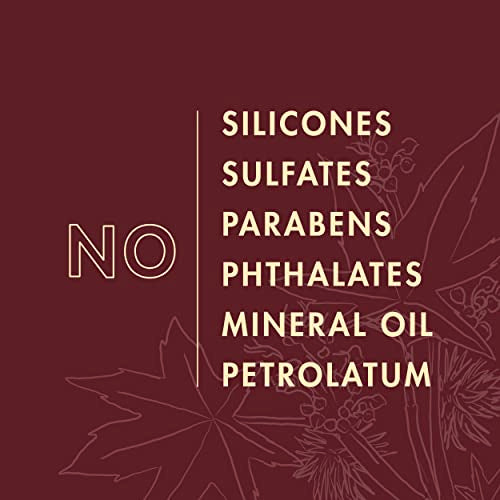
SheaMoisture Shampoo - Strengthens & Nourishes Damaged Hair, Paraben-Free - 24oz


Mentha Piperita (Peppermint) Extract
High RiskMentha piperita extract, commonly known as peppermint extract, is derived from the leaves of the peppermint plant. It is used in various cosmetic and personal care products for its aromatic properties and potential soothing effects on the skin.
Sustai Insights
Mentha piperita extract offers functional benefits such as providing a cooling sensation and pleasant fragrance, enhancing product appeal. However, it carries a high risk of causing allergic reactions and skin irritation, particularly with sensitive individuals. Regulatory bodies have not imposed significant restrictions, but caution is advised due to its allergenic potential. Overall, the ingredient poses a high risk, especially for those with sensitivities, and should be used carefully, with alternatives available for those seeking less irritating options.
Hydrolyzed Wheat Protein
High RiskHydrolyzed wheat protein is produced by acid or enzymatic hydrolysis of wheat gluten, resulting in smaller protein fragments that can be easily absorbed by hair and skin. This ingredient is commonly used in personal care products for its moisturizing and film-forming properties.
Sustai Insights
Hydrolyzed wheat protein offers functional benefits, such as enhancing moisture retention and improving product texture. It is generally considered low risk for carcinogenicity, with moderate potential for allergies. Regulatory restrictions apply, particularly for products that must avoid specific allergens. Environmental concerns include its potential as a pollutant; however, it is not known for bioaccumulation. Safe usage practices are recommended for sensitive individuals, and alternatives like hydrolyzed soy protein may provide similar benefits with reduced allergenic potential. Overall, the ingredient presents a high risk assessment due to use restrictions and allergy concerns.
Fragrance
High RiskFragrance refers to a mixture of aromatic compounds used in products to provide scent. It is commonly listed as 'fragrance' or 'parfum' on product labels and can serve various functions, including enhancing user experience and masking undesirable odors.
Sustai Insights
Fragrance offers functional benefits by improving product appeal; however, it poses significant health risks, notably a high likelihood of causing allergies and allergic contact dermatitis. Environmental risks include potential pollution and endocrine disruption, though its overall carcinogenicity is low. Regulatory bodies have noted concerns regarding its use, leading to a high-risk classification. Safe usage practices should be observed, and alternatives such as natural essential oils are recommended for those sensitive to synthetic fragrances.
Ricinus Communis (Castor) Seed Oil
Medium RiskCastor oil is extracted from the seeds of Ricinus communis and is commonly used in cosmetic and personal care products for its moisturizing and emollient properties. It is known for its ability to enhance skin absorption and provide a protective barrier.
Sustai Insights
Castor oil offers functional benefits as a moisturizer and emollient, enhancing skin absorption and providing a barrier against moisture loss. It is sustainably sourced and biodegradable. However, potential health risks include low levels of irritation and moderate concerns regarding developmental and reproductive toxicity. Environmental risks are low, with no significant pollutant or bioaccumulation concerns reported. Regulatory status shows no current restrictions. Overall, the risk level is assessed as medium, with recommendations for safe usage practices, and potential alternatives include other plant-based oils.
Glycerin
Medium RiskGlycerin (also called glycerol) is a naturally occurring compound commonly used in personal care and cosmetic products. It functions as a humectant, attracting moisture to the skin, and is also utilized as a solvent and emollient to enhance product texture and stability.
Sustai Insights
Glycerin is valued for its effective moisturizing properties and biodegradability, making it a widely accepted ingredient in formulations. It poses low health risks, including low concerns for carcinogenicity and allergies. However, moderate use restrictions exist due to regulatory guidelines. While glycerin does not significantly contribute to environmental pollution, its production process should be ethically sourced. Overall, glycerin holds a medium risk level, emphasizing the importance of safe usage practices and considering sustainable alternatives.
Sodium Benzoate
Medium RiskSodium benzoate is a preservative commonly used in food and cosmetic products to prevent microbial growth and extend shelf life. It is derived from benzoic acid and is effective at low concentrations, often used in acidic environments like beverages and condiments.
Sustai Insights
Sodium benzoate serves effectively as a preservative, contributing to product stability and safety. It is generally recognized as safe with low concerns for carcinogenicity, allergies, and reproductive toxicity, though it faces moderate use restrictions in some regions. Environmental risks include its potential as a pollutant, but it does not bioaccumulate significantly. Regulatory bodies have issued advisories regarding its concentration in products. Overall, the risk level is assessed as medium, with safe usage practices recommended. Alternatives such as potassium sorbate may provide similar benefits with potentially lower restrictions.
Potassium Sorbate
Medium RiskPotassium sorbate is a potassium salt of sorbic acid, primarily used as a preservative in food and cosmetic products. It inhibits the growth of molds, yeast, and some bacteria, extending the shelf life of products. It is commonly found in various formulations due to its effectiveness and low toxicity.
Sustai Insights
Potassium sorbate serves as an effective preservative, preventing microbial growth in food and cosmetic products, which is vital for safety and longevity. Although it has a low risk of carcinogenicity and developmental toxicity, there is a moderate concern regarding allergies and immunotoxicity. Environmentally, it poses minimal risks as it is not significantly bioaccumulative. Regulatory agencies have verified its use, although some products may face restrictions. Overall, it is assessed as a medium risk ingredient, with safe usage practices recommended, and alternatives such as natural preservatives could be considered.
Hydrolyzed Wheat Starch
Low RiskHydrolyzed wheat starch is a hydrolysate of wheat starch that acts as a film-forming agent, thickener, and stabilizer in cosmetic formulations. It enhances the texture and consistency of products while providing moisture retention and a smooth feel on the skin.
Sustai Insights
Hydrolyzed wheat starch offers functional benefits as a thickener and stabilizer, contributing to product texture and moisture retention. It is generally regarded as low risk for health concerns, including carcinogenicity, allergenic potential, and reproductive toxicity. Environmentally, it poses minimal risks and is not known to be bioaccumulative. Regulatory status indicates no significant restrictions, making it a compliant ingredient. Safe usage practices are recommended, and while few alternatives exist, natural thickeners like xanthan gum could be considered. Overall, the ingredient maintains a low risk profile.
Guar Hydroxypropyltrimonium Chloride
Low RiskGuar hydroxypropyltrimonium chloride is a quaternary ammonium compound derived from guar gum, primarily used as a conditioning agent in cosmetic products. It enhances the texture and feel of hair and skin formulations, providing moisture retention and improved manageability.
Sustai Insights
This ingredient offers functional benefits as a conditioning agent, improving the texture and moisture retention in formulations. It is considered low risk regarding health effects, with minimal concerns for carcinogenicity, allergies, or reproductive toxicity. Environmental risks are also low, as it does not accumulate significantly in ecosystems. Regulatory bodies have not imposed significant restrictions. Safe usage practices should be followed, but overall, this ingredient is assessed as low risk, with no immediate concerns regarding alternatives.
Hydrolyzed Keratin
Low RiskHydrolyzed keratin is a hydrolysate of keratin, a fibrous protein found in hair, skin, and nails. It is commonly used in cosmetic and personal care products to improve texture and strength, providing conditioning and moisturizing benefits to hair and skin.
Sustai Insights
Hydrolyzed keratin offers functional benefits as a conditioning agent, enhancing the texture and strength of hair and skin, and is often sourced sustainably. Health risks are low, with no significant concerns regarding carcinogenicity or irritancy. Environmental impacts are minimal, and regulatory bodies impose few restrictions. Overall, the risk level is assessed as low, and safe usage practices are recommended. Alternatives like plant-based proteins may offer similar benefits in a more sustainable manner.
Sodium Lauroyl Lactylate
Low RiskSodium lauroyl lactylate is a sodium salt of lauric acid and lactyl lactate, primarily used in cosmetic formulations as an emulsifier and skin conditioning agent. It helps to enhance the texture and stability of products while also promoting skin feel.
Sustai Insights
Sodium lauroyl lactylate is valued for its emulsifying properties, improving product texture and stability. It is considered biodegradable and sustainably sourced, contributing to eco-friendliness. Health risks are low, with minimal concerns regarding carcinogenicity, allergenic potential, and reproductive toxicity. Environmental risks are also low, with no significant bioaccumulation or pollution potential identified. Regulatory bodies have not imposed restrictions on its use. Overall, this ingredient presents a low risk profile, making it a suitable choice for cosmetic formulations.
Octanohydroxamic Acid
Low RiskOctanohydroxamic acid is a cosmetic ingredient primarily used for its functional properties, including acting as a preservative and stabilizer in various formulations. It is recognized for its ability to enhance product efficacy while maintaining product integrity over time.
Sustai Insights
Octanohydroxamic acid is valued for its effective preservative qualities and low environmental impact, being biodegradable and sustainably sourced. However, it is associated with low risks of irritation and moderate allergic potential, though evidence suggests minimal carcinogenicity and reproductive toxicity. Regulatory advisories recommend cautious use due to irritation risks. Overall, the ingredient presents a low risk profile when used appropriately, making it a suitable choice in cosmetic formulations.
Glycine Soja (Soybean) Oil
Low RiskGlycine soja (soybean) oil is derived from the seeds of the soybean plant and is commonly used in cosmetic formulations for its emollient properties. It functions as a moisturizer and skin conditioning agent, enhancing the texture and feel of products.
Sustai Insights
Glycine soja (soybean) oil offers functional benefits such as effective skin moisturization and conditioning. It is generally recognized as low-risk for health concerns, with minimal allergenic potential and no significant environmental hazards reported. Regulatory bodies have not imposed restrictions on its use. Overall, this ingredient is assessed as low risk, making it a suitable option for various cosmetic applications.
Mauritia Flexuosa Fruit Oil
Low RiskMauritia flexuosa fruit oil is a volatile oil extracted from the fruit of the Mauritia flexuosa palm, commonly known as buriti. It is often used in cosmetic formulations for its moisturizing properties and potential benefits for skin health. The oil is rich in carotenoids and fatty acids.
Sustai Insights
Mauritia flexuosa fruit oil offers functional benefits as a moisturizer and antioxidant due to its composition, which includes carotenoids. It is sustainably sourced and biodegradable. Health risks associated with this ingredient are low, with no known carcinogenic, allergenic, or reproductive toxicity concerns. Environmental risks are minimal, as it does not contribute to pollution or bioaccumulation. Regulatory status shows no significant restrictions. Overall, the risk level is low. Safe usage practices are encouraged, and alternatives include other natural oils like argan or jojoba oil for similar benefits.
Trifolium Pratense (Red Clover) Extract
Low RiskTrifolium pratense (red clover) extract is derived from the flowers of the red clover plant. It is commonly used in various products for its phytoestrogen content, which mimics estrogen in the body, and is often included in formulations aiming to address hormonal balance.
Sustai Insights
This ingredient offers functional benefits as a natural source of phytoestrogens, which may aid in hormonal regulation. It is generally considered low risk for health concerns, such as cancer, allergies, and reproductive toxicity. Environmental risks are minimal, with no significant pollutant potential. Regulatory bodies do not impose restrictions on its use. Overall, red clover extract is assessed as low risk, suitable for inclusion in products with consideration for sensitive populations, and potentially replaced by other phytoestrogen sources.
Hydrolyzed Rice Protein
Low RiskHydrolyzed rice protein is a hydrolysate of rice protein, commonly used in cosmetic and personal care products for its film-forming and moisturizing properties. It serves as a conditioning agent that can enhance the texture and feel of formulations.
Sustai Insights
Hydrolyzed rice protein offers functional benefits such as improving moisture retention and hair manageability. It is derived from renewable sources and is biodegradable. Health risks are generally low, with minimal concerns regarding carcinogenicity, allergies, or reproductive toxicity. However, contamination concerns are noted. Environmental risks appear low, with no significant pollutant or bioaccumulative properties. Regulatory status indicates no major restrictions. Overall, the risk level is assessed as low, making it a viable ingredient in formulations with appropriate usage practices.
Decyl Glucoside
Low RiskDecyl glucoside is a glucose-based surfactant derived from natural sources, primarily used as a mild cleansing agent in personal care products. It effectively reduces surface tension, allowing for improved mixing of ingredients and enhanced cleansing properties without stripping natural oils from the skin.
Sustai Insights
Decyl glucoside offers functional benefits as a non-ionic surfactant, making it suitable for sensitive skin formulations. It is biodegradable and derived from renewable resources, supporting sustainability. Health risks are primarily low, with minimal concerns regarding irritation and allergies. Environmental risks are low, as it does not significantly contribute to pollution or bioaccumulation. Regulatory status is generally favorable, with low restrictions noted. Overall, decyl glucoside presents a low risk for use in consumer products, making it a suitable choice for gentle formulations.
Acetic Acid
Low RiskAcetic acid is an organic acid commonly used in food preservation, as a flavoring agent, and in various industrial applications. It is known for its pungent smell and sour taste, and it serves as an effective acidifying agent in products.
Sustai Insights
Acetic acid serves as an effective preservative and flavor enhancer while being biodegradable and derived from renewable sources. Health risks include low potential for irritation and toxicity, with no significant concerns for carcinogenicity or allergenic reactions. Environmentally, it poses minimal risks and is not bioaccumulative. Regulatory bodies impose few restrictions, indicating a low overall risk level. Safe usage practices include avoiding concentrated forms, while alternatives such as citric acid may offer similar benefits with potentially less risk.
Niacin
Low RiskNiacin is a heterocyclic aromatic compound that serves primarily as a vitamin (vitamin B3) in dietary supplements and fortified foods. It is involved in various metabolic processes, including the conversion of carbohydrates into energy and the maintenance of healthy skin and nerves.
Sustai Insights
Niacin has functional benefits as it plays a crucial role in energy metabolism and skin health. It is generally recognized as safe with low concerns regarding carcinogenicity, allergies, and reproductive toxicity. However, excessive intake may lead to skin irritation or flushing. Niacin does not pose significant environmental risks and is not bioaccumulative. Regulatory bodies have not issued major restrictions, indicating an overall low risk associated with its use. Safe usage practices include adhering to recommended dietary allowances. Alternatives include niacinamide or other B vitamins for similar health benefits.
Caramel Color
Low RiskCaramel color is a concentrated sugary material obtained through the controlled heat treatment of carbohydrates, primarily used as a food coloring agent. It is commonly incorporated in various food and beverage products to impart a brown hue and enhance visual appeal.
Sustai Insights
Caramel color serves effectively as a coloring agent in food products, contributing to aesthetic appeal without substantial health risks. Regulatory assessments indicate low concerns regarding carcinogenicity, allergenic potential, and reproductive toxicity. However, contamination during production may pose risks. While it is generally recognized as safe, its environmental impact is minimal, leading to an overall low-risk assessment. Safe usage practices are advised, and alternatives like natural colorants exist for those seeking eco-friendlier options.
Yeast Extract
Low RiskYeast extract is an extract derived from yeast, commonly used in food and cosmetic products for its flavor-enhancing and nutritional properties. It contains amino acids, vitamins, and minerals that contribute to its functional benefits.
Sustai Insights
Yeast extract serves as a flavor enhancer and nutrient source, contributing to product efficacy. It is generally recognized as safe with low concerns for carcinogenicity, allergies, or reproductive toxicity. Environmental impact is minimal, with no significant pollutant or bioaccumulation potential. Regulatory bodies, such as the FDA, impose no restrictions. Overall, it presents a low-risk profile, with no notable health or environmental hazards, making it a viable ingredient in various applications.
Water
Low RiskWater is a clear, colorless liquid essential for various biological processes. It serves as a solvent in formulations, facilitating the dissolution of other ingredients and enhancing product texture and application. Additionally, water plays a crucial role in hydration and is a key component in many cosmetic and personal care products.
Sustai Insights
Water is an effective solvent and hydrator, contributing to the texture and efficacy of formulations. It is biodegradable and generally regarded as safe, with low concerns regarding carcinogenicity, allergies, and reproductive toxicity. However, excessive water usage can lead to environmental concerns, particularly regarding resource depletion. Regulatory bodies do not impose restrictions on water use in cosmetics. Overall, the risks associated with water are low, making it a safe and essential ingredient.
Panthenol
Low RiskPanthenol, a derivative of vitamin B5, is commonly used in cosmetic formulations for its moisturizing and skin-conditioning properties. It acts as a humectant, helping to retain moisture in the skin and hair, thereby improving hydration and texture.
Sustai Insights
Panthenol offers functional benefits such as effective hydration and skin conditioning, making it valuable in various cosmetic products. It is considered low risk regarding health impacts, with minimal concerns about carcinogenicity, allergies, or reproductive toxicity. Environmental risks are also low, with no significant pollutant or bioaccumulation potential. Regulatory bodies have not imposed restrictions on its use. Safe usage practices include adhering to recommended concentrations. Alternatives like glycerin may provide similar moisturizing benefits, but overall, panthenol is assessed as a low-risk ingredient.
Tocopherol
Low RiskTocopherols are a class of naturally occurring compounds, primarily known for their role as antioxidants. They are commonly used in cosmetic and skincare products to help stabilize formulations and protect ingredients from oxidative damage.
Sustai Insights
Tocopherols provide functional benefits such as antioxidant protection and skin conditioning. They are generally recognized as safe, with low concerns regarding carcinogenicity, allergies, and reproductive toxicity. However, enhanced skin absorption and potential endocrine disruption are noted. Regulatory bodies have not imposed significant restrictions on tocopherols, categorizing the overall risk as low. Safe usage practices should be observed, and while alternatives exist, tocopherols remain a viable option in formulations.
Caprylyl Glycol
Low RiskCaprylyl glycol (1,2-octanediol) is a multifunctional cosmetic ingredient primarily used as a skin-conditioning agent and preservative. It is derived from caprylic acid, a fatty acid found in coconut oil, and is commonly included in personal care products for its moisturizing properties.
Sustai Insights
Caprylyl glycol offers functional benefits such as acting as an effective humectant and preservative, enhancing skin hydration and product stability. It is considered to have low health risks, with no significant concerns regarding carcinogenicity, allergies, or reproductive toxicity. Environmentally, it poses minimal risks, being non-bioaccumulative and not linked to pollution. Regulatory assessments affirm its safety, with no major advisories against its use. Overall, the ingredient is assessed to have a low risk, making it a suitable choice in cosmetic formulations.
Butyrospermum Parkii (Shea) Butter
Low RiskButyrospermum parkii (shea) butter is a vegetable fat derived from the nuts of the shea tree. It is commonly used in cosmetic formulations for its emollient properties, providing moisture and improving skin texture. Additionally, shea butter is known for its ability to enhance the stability of products and deliver a creamy texture.
Sustai Insights
Shea butter offers functional benefits as an effective moisturizer, enhancing skin barrier function and texture. It is sustainably sourced and biodegradable, contributing to eco-friendliness. Health-wise, it is associated with low risks for carcinogenicity, allergies, and reproductive toxicity. Environmental impacts are minimal, with no significant pollutant potential identified. Regulatory assessments indicate no current restrictions. Overall, the ingredient presents a low risk, making it a favorable choice in cosmetic formulations.
Aloe Barbadensis (Aloe Vera) Leaf Juice
Low RiskAloe barbadensis (aloe vera) leaf juice is derived from the succulent aloe vera plant, known for its hydrating and soothing properties. It is commonly used in cosmetic formulations for its moisturizing effects and is often included in products aimed at skin care and healing.
Sustai Insights
Aloe vera leaf juice offers functional benefits as a moisturizer and skin soothing agent, while being sustainably sourced and biodegradable. Health risks are low, with minimal concerns regarding carcinogenicity, allergies, and reproductive toxicity. Environmental impact is also low, with no significant pollutants identified. Regulatory agencies impose few restrictions. Overall, the ingredient poses a low risk, making it a favorable choice in cosmetic formulations.
Hydrolyzed Wheat Starch
Low RiskHydrolyzed wheat starch is a hydrolysate of wheat starch that acts as a film-forming agent, thickener, and stabilizer in cosmetic formulations. It enhances the texture and consistency of products while providing moisture retention and a smooth feel on the skin.
Sustai Insights
Hydrolyzed wheat starch offers functional benefits as a thickener and stabilizer, contributing to product texture and moisture retention. It is generally regarded as low risk for health concerns, including carcinogenicity, allergenic potential, and reproductive toxicity. Environmentally, it poses minimal risks and is not known to be bioaccumulative. Regulatory status indicates no significant restrictions, making it a compliant ingredient. Safe usage practices are recommended, and while few alternatives exist, natural thickeners like xanthan gum could be considered. Overall, the ingredient maintains a low risk profile.
Guar Hydroxypropyltrimonium Chloride
Low RiskGuar hydroxypropyltrimonium chloride is a quaternary ammonium compound derived from guar gum, primarily used as a conditioning agent in cosmetic products. It enhances the texture and feel of hair and skin formulations, providing moisture retention and improved manageability.
Sustai Insights
This ingredient offers functional benefits as a conditioning agent, improving the texture and moisture retention in formulations. It is considered low risk regarding health effects, with minimal concerns for carcinogenicity, allergies, or reproductive toxicity. Environmental risks are also low, as it does not accumulate significantly in ecosystems. Regulatory bodies have not imposed significant restrictions. Safe usage practices should be followed, but overall, this ingredient is assessed as low risk, with no immediate concerns regarding alternatives.
Hydrolyzed Keratin
Low RiskHydrolyzed keratin is a hydrolysate of keratin, a fibrous protein found in hair, skin, and nails. It is commonly used in cosmetic and personal care products to improve texture and strength, providing conditioning and moisturizing benefits to hair and skin.
Sustai Insights
Hydrolyzed keratin offers functional benefits as a conditioning agent, enhancing the texture and strength of hair and skin, and is often sourced sustainably. Health risks are low, with no significant concerns regarding carcinogenicity or irritancy. Environmental impacts are minimal, and regulatory bodies impose few restrictions. Overall, the risk level is assessed as low, and safe usage practices are recommended. Alternatives like plant-based proteins may offer similar benefits in a more sustainable manner.
Sodium Lauroyl Lactylate
Low RiskSodium lauroyl lactylate is a sodium salt of lauric acid and lactyl lactate, primarily used in cosmetic formulations as an emulsifier and skin conditioning agent. It helps to enhance the texture and stability of products while also promoting skin feel.
Sustai Insights
Sodium lauroyl lactylate is valued for its emulsifying properties, improving product texture and stability. It is considered biodegradable and sustainably sourced, contributing to eco-friendliness. Health risks are low, with minimal concerns regarding carcinogenicity, allergenic potential, and reproductive toxicity. Environmental risks are also low, with no significant bioaccumulation or pollution potential identified. Regulatory bodies have not imposed restrictions on its use. Overall, this ingredient presents a low risk profile, making it a suitable choice for cosmetic formulations.
Octanohydroxamic Acid
Low RiskOctanohydroxamic acid is a cosmetic ingredient primarily used for its functional properties, including acting as a preservative and stabilizer in various formulations. It is recognized for its ability to enhance product efficacy while maintaining product integrity over time.
Sustai Insights
Octanohydroxamic acid is valued for its effective preservative qualities and low environmental impact, being biodegradable and sustainably sourced. However, it is associated with low risks of irritation and moderate allergic potential, though evidence suggests minimal carcinogenicity and reproductive toxicity. Regulatory advisories recommend cautious use due to irritation risks. Overall, the ingredient presents a low risk profile when used appropriately, making it a suitable choice in cosmetic formulations.
Glycine Soja (Soybean) Oil
Low RiskGlycine soja (soybean) oil is derived from the seeds of the soybean plant and is commonly used in cosmetic formulations for its emollient properties. It functions as a moisturizer and skin conditioning agent, enhancing the texture and feel of products.
Sustai Insights
Glycine soja (soybean) oil offers functional benefits such as effective skin moisturization and conditioning. It is generally recognized as low-risk for health concerns, with minimal allergenic potential and no significant environmental hazards reported. Regulatory bodies have not imposed restrictions on its use. Overall, this ingredient is assessed as low risk, making it a suitable option for various cosmetic applications.
Mauritia Flexuosa Fruit Oil
Low RiskMauritia flexuosa fruit oil is a volatile oil extracted from the fruit of the Mauritia flexuosa palm, commonly known as buriti. It is often used in cosmetic formulations for its moisturizing properties and potential benefits for skin health. The oil is rich in carotenoids and fatty acids.
Sustai Insights
Mauritia flexuosa fruit oil offers functional benefits as a moisturizer and antioxidant due to its composition, which includes carotenoids. It is sustainably sourced and biodegradable. Health risks associated with this ingredient are low, with no known carcinogenic, allergenic, or reproductive toxicity concerns. Environmental risks are minimal, as it does not contribute to pollution or bioaccumulation. Regulatory status shows no significant restrictions. Overall, the risk level is low. Safe usage practices are encouraged, and alternatives include other natural oils like argan or jojoba oil for similar benefits.
Trifolium Pratense (Red Clover) Extract
Low RiskTrifolium pratense (red clover) extract is derived from the flowers of the red clover plant. It is commonly used in various products for its phytoestrogen content, which mimics estrogen in the body, and is often included in formulations aiming to address hormonal balance.
Sustai Insights
This ingredient offers functional benefits as a natural source of phytoestrogens, which may aid in hormonal regulation. It is generally considered low risk for health concerns, such as cancer, allergies, and reproductive toxicity. Environmental risks are minimal, with no significant pollutant potential. Regulatory bodies do not impose restrictions on its use. Overall, red clover extract is assessed as low risk, suitable for inclusion in products with consideration for sensitive populations, and potentially replaced by other phytoestrogen sources.
Mentha Piperita (Peppermint) Extract
High RiskMentha piperita extract, commonly known as peppermint extract, is derived from the leaves of the peppermint plant. It is used in various cosmetic and personal care products for its aromatic properties and potential soothing effects on the skin.
Sustai Insights
Mentha piperita extract offers functional benefits such as providing a cooling sensation and pleasant fragrance, enhancing product appeal. However, it carries a high risk of causing allergic reactions and skin irritation, particularly with sensitive individuals. Regulatory bodies have not imposed significant restrictions, but caution is advised due to its allergenic potential. Overall, the ingredient poses a high risk, especially for those with sensitivities, and should be used carefully, with alternatives available for those seeking less irritating options.
Hydrolyzed Rice Protein
Low RiskHydrolyzed rice protein is a hydrolysate of rice protein, commonly used in cosmetic and personal care products for its film-forming and moisturizing properties. It serves as a conditioning agent that can enhance the texture and feel of formulations.
Sustai Insights
Hydrolyzed rice protein offers functional benefits such as improving moisture retention and hair manageability. It is derived from renewable sources and is biodegradable. Health risks are generally low, with minimal concerns regarding carcinogenicity, allergies, or reproductive toxicity. However, contamination concerns are noted. Environmental risks appear low, with no significant pollutant or bioaccumulative properties. Regulatory status indicates no major restrictions. Overall, the risk level is assessed as low, making it a viable ingredient in formulations with appropriate usage practices.
Hydrolyzed Wheat Protein
High RiskHydrolyzed wheat protein is produced by acid or enzymatic hydrolysis of wheat gluten, resulting in smaller protein fragments that can be easily absorbed by hair and skin. This ingredient is commonly used in personal care products for its moisturizing and film-forming properties.
Sustai Insights
Hydrolyzed wheat protein offers functional benefits, such as enhancing moisture retention and improving product texture. It is generally considered low risk for carcinogenicity, with moderate potential for allergies. Regulatory restrictions apply, particularly for products that must avoid specific allergens. Environmental concerns include its potential as a pollutant; however, it is not known for bioaccumulation. Safe usage practices are recommended for sensitive individuals, and alternatives like hydrolyzed soy protein may provide similar benefits with reduced allergenic potential. Overall, the ingredient presents a high risk assessment due to use restrictions and allergy concerns.
Decyl Glucoside
Low RiskDecyl glucoside is a glucose-based surfactant derived from natural sources, primarily used as a mild cleansing agent in personal care products. It effectively reduces surface tension, allowing for improved mixing of ingredients and enhanced cleansing properties without stripping natural oils from the skin.
Sustai Insights
Decyl glucoside offers functional benefits as a non-ionic surfactant, making it suitable for sensitive skin formulations. It is biodegradable and derived from renewable resources, supporting sustainability. Health risks are primarily low, with minimal concerns regarding irritation and allergies. Environmental risks are low, as it does not significantly contribute to pollution or bioaccumulation. Regulatory status is generally favorable, with low restrictions noted. Overall, decyl glucoside presents a low risk for use in consumer products, making it a suitable choice for gentle formulations.
Acetic Acid
Low RiskAcetic acid is an organic acid commonly used in food preservation, as a flavoring agent, and in various industrial applications. It is known for its pungent smell and sour taste, and it serves as an effective acidifying agent in products.
Sustai Insights
Acetic acid serves as an effective preservative and flavor enhancer while being biodegradable and derived from renewable sources. Health risks include low potential for irritation and toxicity, with no significant concerns for carcinogenicity or allergenic reactions. Environmentally, it poses minimal risks and is not bioaccumulative. Regulatory bodies impose few restrictions, indicating a low overall risk level. Safe usage practices include avoiding concentrated forms, while alternatives such as citric acid may offer similar benefits with potentially less risk.
Niacin
Low RiskNiacin is a heterocyclic aromatic compound that serves primarily as a vitamin (vitamin B3) in dietary supplements and fortified foods. It is involved in various metabolic processes, including the conversion of carbohydrates into energy and the maintenance of healthy skin and nerves.
Sustai Insights
Niacin has functional benefits as it plays a crucial role in energy metabolism and skin health. It is generally recognized as safe with low concerns regarding carcinogenicity, allergies, and reproductive toxicity. However, excessive intake may lead to skin irritation or flushing. Niacin does not pose significant environmental risks and is not bioaccumulative. Regulatory bodies have not issued major restrictions, indicating an overall low risk associated with its use. Safe usage practices include adhering to recommended dietary allowances. Alternatives include niacinamide or other B vitamins for similar health benefits.
Caramel Color
Low RiskCaramel color is a concentrated sugary material obtained through the controlled heat treatment of carbohydrates, primarily used as a food coloring agent. It is commonly incorporated in various food and beverage products to impart a brown hue and enhance visual appeal.
Sustai Insights
Caramel color serves effectively as a coloring agent in food products, contributing to aesthetic appeal without substantial health risks. Regulatory assessments indicate low concerns regarding carcinogenicity, allergenic potential, and reproductive toxicity. However, contamination during production may pose risks. While it is generally recognized as safe, its environmental impact is minimal, leading to an overall low-risk assessment. Safe usage practices are advised, and alternatives like natural colorants exist for those seeking eco-friendlier options.
Yeast Extract
Low RiskYeast extract is an extract derived from yeast, commonly used in food and cosmetic products for its flavor-enhancing and nutritional properties. It contains amino acids, vitamins, and minerals that contribute to its functional benefits.
Sustai Insights
Yeast extract serves as a flavor enhancer and nutrient source, contributing to product efficacy. It is generally recognized as safe with low concerns for carcinogenicity, allergies, or reproductive toxicity. Environmental impact is minimal, with no significant pollutant or bioaccumulation potential. Regulatory bodies, such as the FDA, impose no restrictions. Overall, it presents a low-risk profile, with no notable health or environmental hazards, making it a viable ingredient in various applications.
Ricinus Communis (Castor) Seed Oil
Medium RiskCastor oil is extracted from the seeds of Ricinus communis and is commonly used in cosmetic and personal care products for its moisturizing and emollient properties. It is known for its ability to enhance skin absorption and provide a protective barrier.
Sustai Insights
Castor oil offers functional benefits as a moisturizer and emollient, enhancing skin absorption and providing a barrier against moisture loss. It is sustainably sourced and biodegradable. However, potential health risks include low levels of irritation and moderate concerns regarding developmental and reproductive toxicity. Environmental risks are low, with no significant pollutant or bioaccumulation concerns reported. Regulatory status shows no current restrictions. Overall, the risk level is assessed as medium, with recommendations for safe usage practices, and potential alternatives include other plant-based oils.
Water
Low RiskWater is a clear, colorless liquid essential for various biological processes. It serves as a solvent in formulations, facilitating the dissolution of other ingredients and enhancing product texture and application. Additionally, water plays a crucial role in hydration and is a key component in many cosmetic and personal care products.
Sustai Insights
Water is an effective solvent and hydrator, contributing to the texture and efficacy of formulations. It is biodegradable and generally regarded as safe, with low concerns regarding carcinogenicity, allergies, and reproductive toxicity. However, excessive water usage can lead to environmental concerns, particularly regarding resource depletion. Regulatory bodies do not impose restrictions on water use in cosmetics. Overall, the risks associated with water are low, making it a safe and essential ingredient.
Glycerin
Medium RiskGlycerin (also called glycerol) is a naturally occurring compound commonly used in personal care and cosmetic products. It functions as a humectant, attracting moisture to the skin, and is also utilized as a solvent and emollient to enhance product texture and stability.
Sustai Insights
Glycerin is valued for its effective moisturizing properties and biodegradability, making it a widely accepted ingredient in formulations. It poses low health risks, including low concerns for carcinogenicity and allergies. However, moderate use restrictions exist due to regulatory guidelines. While glycerin does not significantly contribute to environmental pollution, its production process should be ethically sourced. Overall, glycerin holds a medium risk level, emphasizing the importance of safe usage practices and considering sustainable alternatives.
Fragrance
High RiskFragrance refers to a mixture of aromatic compounds used in products to provide scent. It is commonly listed as 'fragrance' or 'parfum' on product labels and can serve various functions, including enhancing user experience and masking undesirable odors.
Sustai Insights
Fragrance offers functional benefits by improving product appeal; however, it poses significant health risks, notably a high likelihood of causing allergies and allergic contact dermatitis. Environmental risks include potential pollution and endocrine disruption, though its overall carcinogenicity is low. Regulatory bodies have noted concerns regarding its use, leading to a high-risk classification. Safe usage practices should be observed, and alternatives such as natural essential oils are recommended for those sensitive to synthetic fragrances.
Panthenol
Low RiskPanthenol, a derivative of vitamin B5, is commonly used in cosmetic formulations for its moisturizing and skin-conditioning properties. It acts as a humectant, helping to retain moisture in the skin and hair, thereby improving hydration and texture.
Sustai Insights
Panthenol offers functional benefits such as effective hydration and skin conditioning, making it valuable in various cosmetic products. It is considered low risk regarding health impacts, with minimal concerns about carcinogenicity, allergies, or reproductive toxicity. Environmental risks are also low, with no significant pollutant or bioaccumulation potential. Regulatory bodies have not imposed restrictions on its use. Safe usage practices include adhering to recommended concentrations. Alternatives like glycerin may provide similar moisturizing benefits, but overall, panthenol is assessed as a low-risk ingredient.
Tocopherol
Low RiskTocopherols are a class of naturally occurring compounds, primarily known for their role as antioxidants. They are commonly used in cosmetic and skincare products to help stabilize formulations and protect ingredients from oxidative damage.
Sustai Insights
Tocopherols provide functional benefits such as antioxidant protection and skin conditioning. They are generally recognized as safe, with low concerns regarding carcinogenicity, allergies, and reproductive toxicity. However, enhanced skin absorption and potential endocrine disruption are noted. Regulatory bodies have not imposed significant restrictions on tocopherols, categorizing the overall risk as low. Safe usage practices should be observed, and while alternatives exist, tocopherols remain a viable option in formulations.
Caprylyl Glycol
Low RiskCaprylyl glycol (1,2-octanediol) is a multifunctional cosmetic ingredient primarily used as a skin-conditioning agent and preservative. It is derived from caprylic acid, a fatty acid found in coconut oil, and is commonly included in personal care products for its moisturizing properties.
Sustai Insights
Caprylyl glycol offers functional benefits such as acting as an effective humectant and preservative, enhancing skin hydration and product stability. It is considered to have low health risks, with no significant concerns regarding carcinogenicity, allergies, or reproductive toxicity. Environmentally, it poses minimal risks, being non-bioaccumulative and not linked to pollution. Regulatory assessments affirm its safety, with no major advisories against its use. Overall, the ingredient is assessed to have a low risk, making it a suitable choice in cosmetic formulations.
Sodium Benzoate
Medium RiskSodium benzoate is a preservative commonly used in food and cosmetic products to prevent microbial growth and extend shelf life. It is derived from benzoic acid and is effective at low concentrations, often used in acidic environments like beverages and condiments.
Sustai Insights
Sodium benzoate serves effectively as a preservative, contributing to product stability and safety. It is generally recognized as safe with low concerns for carcinogenicity, allergies, and reproductive toxicity, though it faces moderate use restrictions in some regions. Environmental risks include its potential as a pollutant, but it does not bioaccumulate significantly. Regulatory bodies have issued advisories regarding its concentration in products. Overall, the risk level is assessed as medium, with safe usage practices recommended. Alternatives such as potassium sorbate may provide similar benefits with potentially lower restrictions.
Potassium Sorbate
Medium RiskPotassium sorbate is a potassium salt of sorbic acid, primarily used as a preservative in food and cosmetic products. It inhibits the growth of molds, yeast, and some bacteria, extending the shelf life of products. It is commonly found in various formulations due to its effectiveness and low toxicity.
Sustai Insights
Potassium sorbate serves as an effective preservative, preventing microbial growth in food and cosmetic products, which is vital for safety and longevity. Although it has a low risk of carcinogenicity and developmental toxicity, there is a moderate concern regarding allergies and immunotoxicity. Environmentally, it poses minimal risks as it is not significantly bioaccumulative. Regulatory agencies have verified its use, although some products may face restrictions. Overall, it is assessed as a medium risk ingredient, with safe usage practices recommended, and alternatives such as natural preservatives could be considered.
Butyrospermum Parkii (Shea) Butter
Low RiskButyrospermum parkii (shea) butter is a vegetable fat derived from the nuts of the shea tree. It is commonly used in cosmetic formulations for its emollient properties, providing moisture and improving skin texture. Additionally, shea butter is known for its ability to enhance the stability of products and deliver a creamy texture.
Sustai Insights
Shea butter offers functional benefits as an effective moisturizer, enhancing skin barrier function and texture. It is sustainably sourced and biodegradable, contributing to eco-friendliness. Health-wise, it is associated with low risks for carcinogenicity, allergies, and reproductive toxicity. Environmental impacts are minimal, with no significant pollutant potential identified. Regulatory assessments indicate no current restrictions. Overall, the ingredient presents a low risk, making it a favorable choice in cosmetic formulations.
Aloe Barbadensis (Aloe Vera) Leaf Juice
Low RiskAloe barbadensis (aloe vera) leaf juice is derived from the succulent aloe vera plant, known for its hydrating and soothing properties. It is commonly used in cosmetic formulations for its moisturizing effects and is often included in products aimed at skin care and healing.
Sustai Insights
Aloe vera leaf juice offers functional benefits as a moisturizer and skin soothing agent, while being sustainably sourced and biodegradable. Health risks are low, with minimal concerns regarding carcinogenicity, allergies, and reproductive toxicity. Environmental impact is also low, with no significant pollutants identified. Regulatory agencies impose few restrictions. Overall, the ingredient poses a low risk, making it a favorable choice in cosmetic formulations.
Discover the SheaMoisture Jamaican Black Castor Oil Strengthen & Restore Shampoo, a sulfate-free solution designed for damaged hair. This nourishing shampoo not only cleanses but also revitalizes, making it ideal for color-treated, heat-styled, and natural hair types.
- Gentle Cleansing: Effectively removes buildup without stripping moisture, promoting healthier hair.
- Nourishing Ingredients: Infused with Jamaican Black Castor Oil and Shea Butter to strengthen and restore damaged strands.
- Versatile Use: Perfect for all hair types, especially those frequently colored or styled with heat.
- Cruelty-Free: Committed to ethical practices, ensuring no animal testing and using sustainably sourced ingredients.
- Family-Tested Formula: Crafted with care, this shampoo has been trusted by generations for its gentle yet effective cleansing properties.
Empower your hair care routine with this eco-conscious choice that aligns with your health and environmental values.
Subscribe & Save with Sustai
- Best Price Guarantee: Always enjoy the lowest prices on sustainable home essentials.
- No Surprises: We’ll notify you before shipping. No hidden fees, ever.
- You’re in Charge: Change, pause, or cancel your subscription anytime with ease.
- Eco-Friendly Deliveries: Our grouped shipments mean less packaging and lower emissions.
Join us on a sustainable journey. Special offers for a limited time! Prices and promotions may change.
Recommended Products
Discover the SheaMoisture Jamaican Black Castor Oil Strengthen & Restore Shampoo, a sulfate-free solution designed for damaged hair. This nourishing shampoo not only cleanses but also revitalizes, making it ideal for color-treated, heat-styled, and natural hair types.
- Gentle Cleansing: Effectively removes buildup without stripping moisture, promoting healthier hair.
- Nourishing Ingredients: Infused with Jamaican Black Castor Oil and Shea Butter to strengthen and restore damaged strands.
- Versatile Use: Perfect for all hair types, especially those frequently colored or styled with heat.
- Cruelty-Free: Committed to ethical practices, ensuring no animal testing and using sustainably sourced ingredients.
- Family-Tested Formula: Crafted with care, this shampoo has been trusted by generations for its gentle yet effective cleansing properties.
Empower your hair care routine with this eco-conscious choice that aligns with your health and environmental values.

You can have at most 2 Sustainable Steals products in your cart
Customer Reviews
Customers’ View
Customers appreciate the gentle and effective cleansing properties of SheaMoisture's Strengthen and Restore Shampoo. Many users highlight its sulfate-free formula, which leaves their hair feeling soft, clean, and easy to manage, without stripping color from dyed hair. The shampoo's nourishing ingredients, including Jamaican Black Castor Oil and Shea Butter, contribute to improved hair health and moisture retention, making it suitable for various hair types. However, some customers have reported issues with the pump dispenser, noting that it can break easily. Overall, this product aligns with eco-conscious values, being cruelty-free and made from sustainable ingredients, which resonates well with health-conscious consumers.
AI-generated from the text of customer reviewsThis product is rated 4.6 of 5.0 stars.
It has received 14 reviews.




